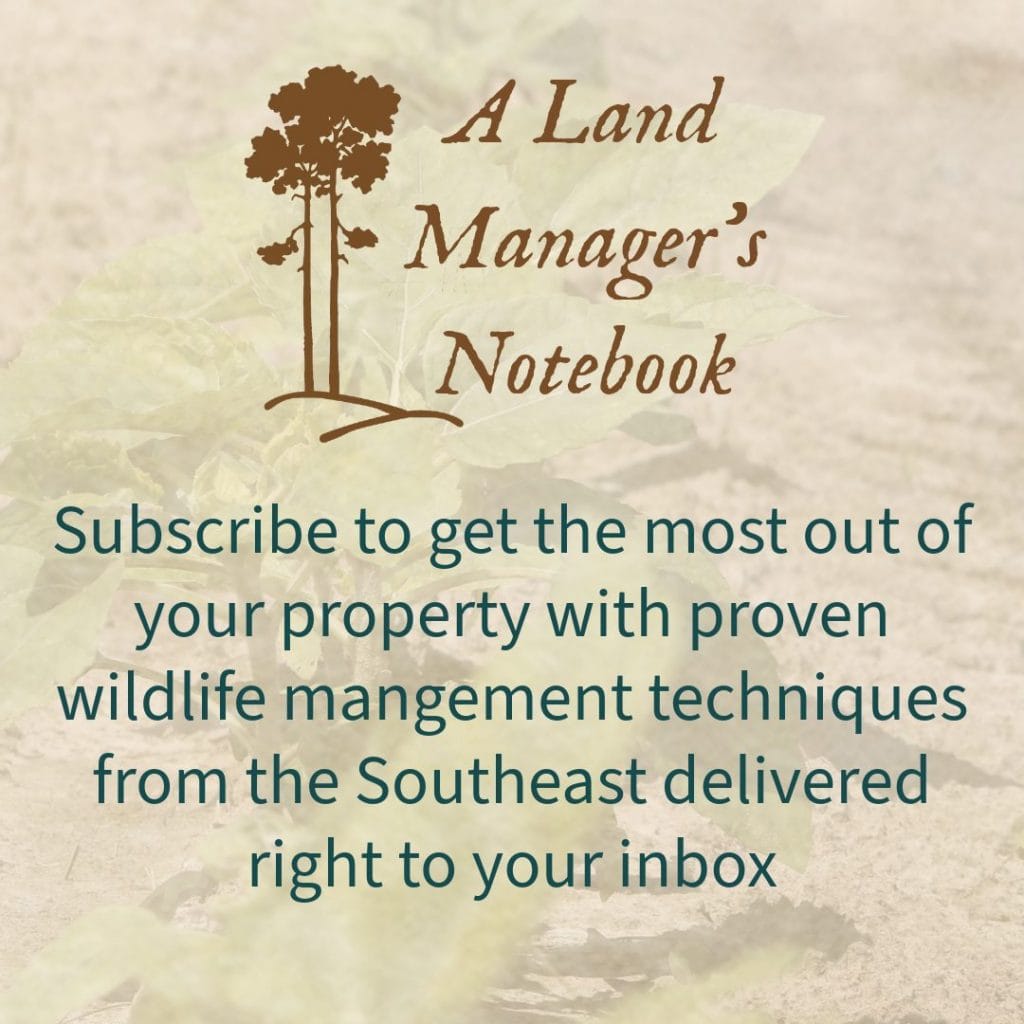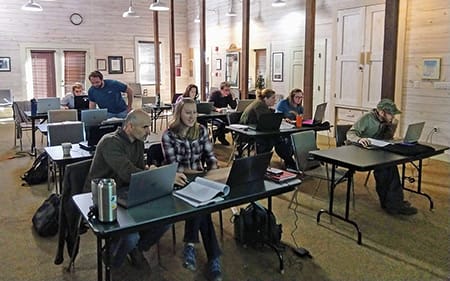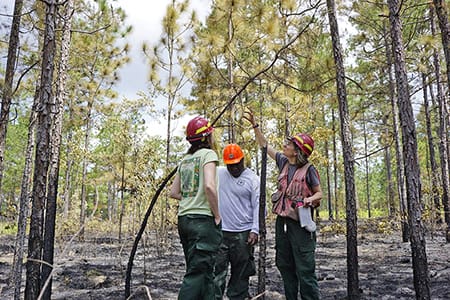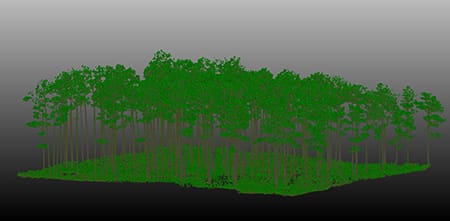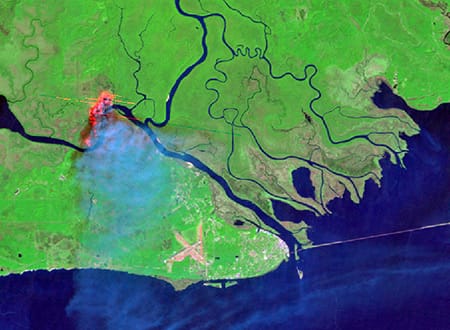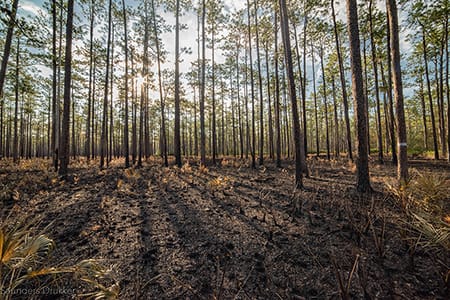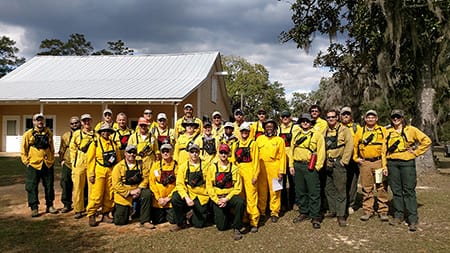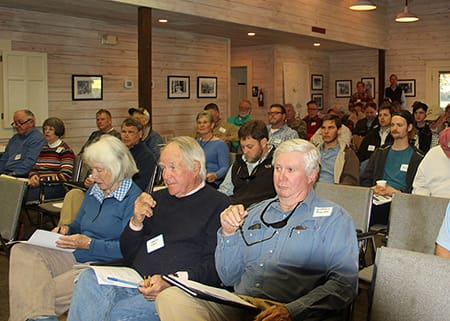This study was done as part of a collaborative project with the University of Georgia and appeared in in the Winter 2018 edition of the Tall Timbers eJournal
The more bobwhite quail are chased by predators, the more they shift their behavioral response to pressure and become harder to harvest.
Hunting pressure is no different, and for game species, humans have become an integrated part of this dynamic often asserting equal or greater pressures on prey species than natural predators, which can cause quail to shift their feeding habits.
Foraging is a particular risky time for ground dwelling animals, such as the bobwhite, because quality food sources often occur in open areas that increase visibility to predators.
Even where high quality cover exists on foraging grounds, such as where supplemental feed is broadcast into dense cover, bobwhites are more vulnerable while feeding due to reduced vigilance.
Many bobwhite managers use supplemental feeding as its benefits have been shown to reduce quail movement, improve survival and increase body condition of hens going into breeding season.
However, during hunting season these areas also tend to be targeted by hunters creating competing risks for bobwhites: high reward of readily available food and high risk of encountering a predator.
To evaluate this more closely, researchers investigated bobwhite foraging strategies under varying levels of exposure to hunters, monitoring covey encounters and shotgun exposure during hunts on a private plantation in Georgetown County, South Carolina.
In 2021, Tall Timbers researchers restarted the covey-hunter interaction study at six different sites in Florida, Georgia, and Texas and in early observations found quail to be more “wary” than the original study.
Daily movements of quail were tracked by telemetry throughout hunting season to collect typical locations and foraging behavior.
Those movements were then compared to the influence various aspects of hunting, such as distance from a pointing dog and shotgun exposure, had on birds.
In the study, undisturbed bobwhite coveys on average forage for three hours with a range of one to four hours using a foraging area, usually less than an acre, when overlapping supplemental feed.
Hunting pressure negatively influenced feeding, prompting a general decrease in foraging duration and area suggesting that shorter, more frequent foraging forays limited bobwhite exposure to human hunting pressure while still meeting their daily nutritional requirements.
Coveys shot into tended to shift their foraging time by approximately 30 minutes from peak hunting hours 11 p.m. and 4 p.m., compared to those less pressured coveys, likely to allow time to feed and avoid perceived threats.
Results of the study demonstrated that bobwhites learn patterns associated with risk and respond in such a way to minimize risk through behavioral shifts during foraging.
This study demonstrates behavioral modifications in foraging for a game species related to hunting pressure.
Take Home Message
Natural predators of the bobwhites such as snakes and hawks present a background level of predation year-round creating unique patterns of predation pressure that may alter bobwhite behavior, movement and home ranges.
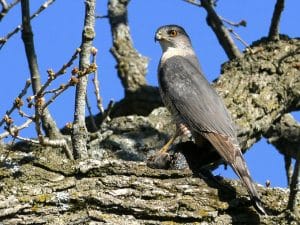
Natural predators like the Cooper’s Hawk present background predation pressure year-round that can alter bobwhite behavior.
Previous research suggests that Cooper’s hawks locate a covey and focus predation on that individual covey until their hunting efficiency declines to a point of diminishing return. Supplemental feeding likely provides increased opportunity to evade predators through alteration of feeding times and frequency of feeding while reducing their exposure. This underscores the potential value of broadcasting supplemental food into areas of good cover for foraging coveys.
For the human hunter, altering hunting times may reduce the amount of associated learning by bobwhites in response to hunting activity, thereby potentially increasing hunter satisfaction and overall hunt success. Given that bobwhites altered their foraging behavior in response to encounters with hunters such that they reduced their foraging duration and restricted their foraging area, we recommend that hunters maximize their coverage and not limit their hunting efforts to the feedline for improved covey detection, especially during late season when experienced coveys may have already modified their foraging patterns.
This may also help to explain why some coveys are less “predictable” and feed more inconsistently toward the end of the season compared to beginning of the season.
The use of GPS technology to track hunter and dog coverage can help to identify potentially under used areas. We found that bobwhites used supplemental feed to compensate for decreased foraging duration and area.
Thus, the provision of supplemental feed may be advantageous for bobwhite survival when it is evenly distributed throughout the property and not spatially concentrated.
However, feeding too much, too frequently may result in reduced natural mortality but also may result in a reduction in hunt success.
In a similar vein, too much hunting pressure will result in behavioral responses by bobwhite coveys to curtail exposure and predation from hunters.
Behavioral shifts in timing and duration of foraging and increased movement to evade hunters likely has negative consequences on survival through natural mortality.
This emphasizes the importance of proper habitat management, judicious harvest and the use of supplemental feed to potentially offset natural predation pressure during hunting season while underscoring the need to balance hunting opportunity and pressure with bobwhite survival.


